-
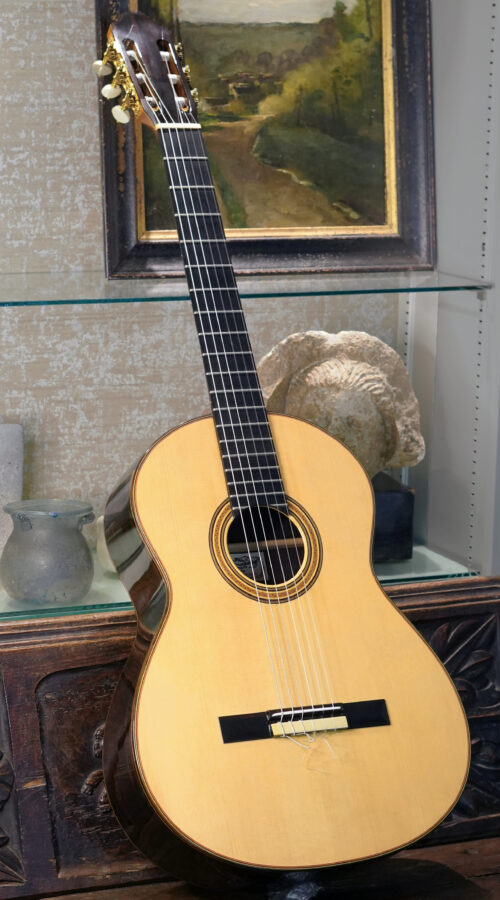 Ken Miller, a great and meticulous luthier, is now retired and is not taking any guitar orders. He started building in early 1960s and in the 1970’s worked at Guild Guitars in Rhode Island, in a variety of positions. He was a full-time luthier with his own brand of guitars from 1999 until retirement in 2015. His guitars are hard to come by – especially his classical guitars as he made only a small number of classicals over the years. “I made all of my Classical and Flamenco guitars in 650mm scale, and with the body size and shape of this one,” said Ken in a recent conversation with us. “The Flamenco guitars had slightly different internals, lower bridge and were made with Spanish Cypress back & sides, and friction pegs. All I made, classical or flamenco, were 650mm scale. I think that those Spanish instruments from about 1900 through the '30's were the cream of the crop. I don't care for the modern, larger classical guitars… My two guitar heroes were Santos Hernandez, and CF Martin.” See/listen to a recording of this guitar being played, in the video posted here. This classical guitar is 20 years old, but you can’t tell by looking at it, it’s near pristine in terms of play wear. It has a big, rich, lush sound. It really excels in the ringing Brazilian rosewood trebles. And it’s one of the few guitars you’ll find where you can get incredible nuance with just a light touch. • Serial number: #70, made in 2003. (Signed as such on label) • Old growth, dark Brazilian Rosewood back/sides, head plate overlay, binding and bridge. (Note, a few “eyes” in the Brazilian on back, were wormholes in the very dark, very old Brazilian that the luthier very well plugged before putting the guitar together.) • The top, and internal bracings are Adirondack (Red) Spruce • There are 7 slender fan braces with a thin horizontal brace under the bridge area between braces 1 and 7 • Ebony fingerboard • Spanish Cedar internal lining as is the neck which has a graphite reinforcement. Fitted to the body with a traditional Spanish foot. • Nut, saddle & bridge tie plate are Fossil Ivory. • Nut is 51.5mm • 650mm scale • Handmade rosette • Oil varnish finish • Gotoh Deluxe tuners with Ivoroid tuner buttons There is one, very small crack that’s difficult to see/photograph on the back of the guitar near the center seam that is near the area of the end pin. The top of the guitar, with no cracks whatsoever, looks virtually unplayed, as does the fretboard and frets. This guitar sold for $6,000 new, in 2003, and it’s about as close to that original ’03 condition as you can get. With its very dark, old growth Brazilian rosewood, it’s easily comparable in build quality, materials, and sound, to classicals in the $8-14K range today. Price: $4,850. With modern case.
Ken Miller, a great and meticulous luthier, is now retired and is not taking any guitar orders. He started building in early 1960s and in the 1970’s worked at Guild Guitars in Rhode Island, in a variety of positions. He was a full-time luthier with his own brand of guitars from 1999 until retirement in 2015. His guitars are hard to come by – especially his classical guitars as he made only a small number of classicals over the years. “I made all of my Classical and Flamenco guitars in 650mm scale, and with the body size and shape of this one,” said Ken in a recent conversation with us. “The Flamenco guitars had slightly different internals, lower bridge and were made with Spanish Cypress back & sides, and friction pegs. All I made, classical or flamenco, were 650mm scale. I think that those Spanish instruments from about 1900 through the '30's were the cream of the crop. I don't care for the modern, larger classical guitars… My two guitar heroes were Santos Hernandez, and CF Martin.” See/listen to a recording of this guitar being played, in the video posted here. This classical guitar is 20 years old, but you can’t tell by looking at it, it’s near pristine in terms of play wear. It has a big, rich, lush sound. It really excels in the ringing Brazilian rosewood trebles. And it’s one of the few guitars you’ll find where you can get incredible nuance with just a light touch. • Serial number: #70, made in 2003. (Signed as such on label) • Old growth, dark Brazilian Rosewood back/sides, head plate overlay, binding and bridge. (Note, a few “eyes” in the Brazilian on back, were wormholes in the very dark, very old Brazilian that the luthier very well plugged before putting the guitar together.) • The top, and internal bracings are Adirondack (Red) Spruce • There are 7 slender fan braces with a thin horizontal brace under the bridge area between braces 1 and 7 • Ebony fingerboard • Spanish Cedar internal lining as is the neck which has a graphite reinforcement. Fitted to the body with a traditional Spanish foot. • Nut, saddle & bridge tie plate are Fossil Ivory. • Nut is 51.5mm • 650mm scale • Handmade rosette • Oil varnish finish • Gotoh Deluxe tuners with Ivoroid tuner buttons There is one, very small crack that’s difficult to see/photograph on the back of the guitar near the center seam that is near the area of the end pin. The top of the guitar, with no cracks whatsoever, looks virtually unplayed, as does the fretboard and frets. This guitar sold for $6,000 new, in 2003, and it’s about as close to that original ’03 condition as you can get. With its very dark, old growth Brazilian rosewood, it’s easily comparable in build quality, materials, and sound, to classicals in the $8-14K range today. Price: $4,850. With modern case. -
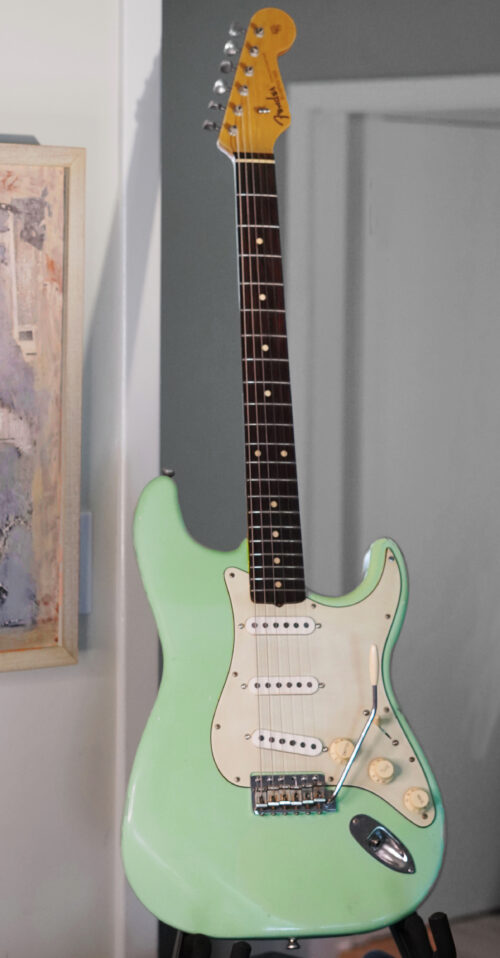 63 Surf Green Strat tribute. Impeccable attention to detail. And more importantly, the right sound, and feel. It never left the Fullerton factory as you see it here – it’s a great tribute build that not only looks right, it plays like a dream. Loud and resonant, even when not plugged in. You can spend $6K plus, on a recent Fender Custom Shop versions, but it won't look this good and it won't play like this. Thin nitro cellulose finish, with light relic. Klein pickups, the choice of players who need the best authentic sound. Includes many Fender licensed parts, that makes it legit on the market. Strat is '63 spec, and note it has a chunky neck. Surf Green is as it should be, with the just a tiny touch of yellowy tint in places on guitar top, as what happens to a true vintage Surf Green finish after years of fading. Price: $3650. Ships in a well-used modern strat case.
63 Surf Green Strat tribute. Impeccable attention to detail. And more importantly, the right sound, and feel. It never left the Fullerton factory as you see it here – it’s a great tribute build that not only looks right, it plays like a dream. Loud and resonant, even when not plugged in. You can spend $6K plus, on a recent Fender Custom Shop versions, but it won't look this good and it won't play like this. Thin nitro cellulose finish, with light relic. Klein pickups, the choice of players who need the best authentic sound. Includes many Fender licensed parts, that makes it legit on the market. Strat is '63 spec, and note it has a chunky neck. Surf Green is as it should be, with the just a tiny touch of yellowy tint in places on guitar top, as what happens to a true vintage Surf Green finish after years of fading. Price: $3650. Ships in a well-used modern strat case. -
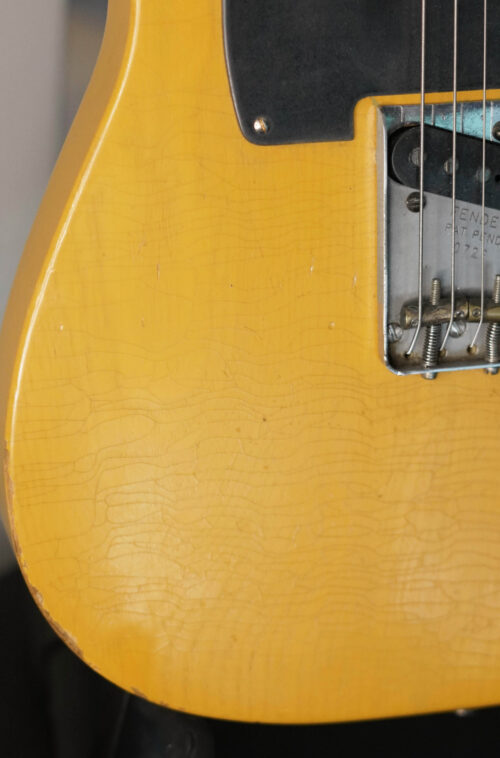 52 Broadcaster. Impeccable attention to detail. Great sound, and feel. No, it never left the Fullerton factory as you see it here. This is one of the best tribute builds you'll find, at any price, done by real players. You can spend $6K plus, on a recent Fender Custom Shop version, but it won't look this good and it won't play like this. The best nitro cellulose finish, with light relic, and crazing. MJT body. Warmoth Fender licensed birds eye maple neck, chunky C-shape. Duncan Antiquity pickups. The bridge– with the numbers you see– is not available on a "Custom Shop" or reissue. It was custom made and on the instrument when we acquired it. Price: $3750. Ships in a well-worn modern tele case.
52 Broadcaster. Impeccable attention to detail. Great sound, and feel. No, it never left the Fullerton factory as you see it here. This is one of the best tribute builds you'll find, at any price, done by real players. You can spend $6K plus, on a recent Fender Custom Shop version, but it won't look this good and it won't play like this. The best nitro cellulose finish, with light relic, and crazing. MJT body. Warmoth Fender licensed birds eye maple neck, chunky C-shape. Duncan Antiquity pickups. The bridge– with the numbers you see– is not available on a "Custom Shop" or reissue. It was custom made and on the instrument when we acquired it. Price: $3750. Ships in a well-worn modern tele case. -
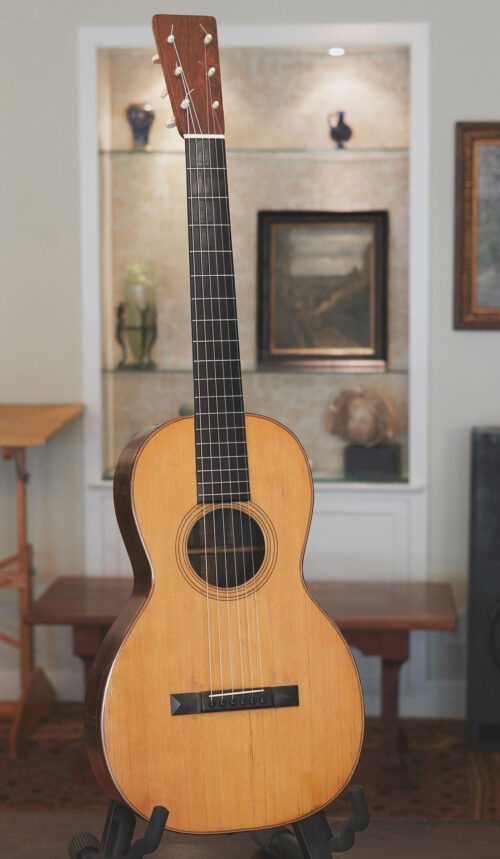
In this period (any Martin guitar made before 1898) there were of course no serial numbers on Martins, and no one signed the instruments inside with a date as they often did in the later 1880’s. But it has all the hallmarks of 1870s to mid-1880’s – and most likely earlier in that period, about 1870, judging by the endstrip material.
It has the original friction tuners – with the exception of the Low E string tuner that was missing and so has been replaced (probably a hundred years ago) with a tuning peg to match the originals.
The size 2 is a great size, it’s a larger guitar than the more common size 2 ½ from this era.
Amazing tone from this guitar. See and hear this guitar being played:
All careful work has been done on this guitar, and it won’t need anything else – it’s a great guitar for the player who wants the best Martin tone and playability – a tonal gem from the 19th century Martin factory in Nazareth.
• Spruce top over Brazilian Rosewood back and sides.
• Spanish heel (not the ice cream cone heel of the less expensive Martins)
• Peg head, with original tuners (with one replacement– the high E string peg)
• Light overspray on top done ages ago, so it’s not very noticeable.
A bit more overspray on back and sides, done decades and decades ago.
• Fan braced – as are most of the best sounding Martins from this era.
• Original thin maple bridge plate
• Original ebony fretboard; Original bar frets with some wear but they’re still pretty high.
• Soft V neck
• Scale length: 24.5 inches
• Width at lower bout: 12 inches
• Nut width: 1 13/16 inch
Multiple cracks on top, all repaired (see photos); multiple cracks on back, all repaired.
Heel has a tiny crack – but it looks like there was never any separation, more of surface crack (see photos)
Two areas by top edge of bridge, either end, where wood was splintered a bit, now repaired and stable. (See photos)
This guitar has seen multiple crack repairs, but it’s structurally sound now, and needs no work going forward. It’s priced low to reflect the work done. It has marvelous sound and projection, and plays with great low action and great intonation all up and down the fretboard. Strung with Savarez Alliance strings.
It would be a great addition to a player wanting a superb example of the best Martin sound from the 19th century – at an affordable cost that’s impossible to find in today’s market.
Ships in a modern hard shell case.
Price: $4,850. – plus shipping
-
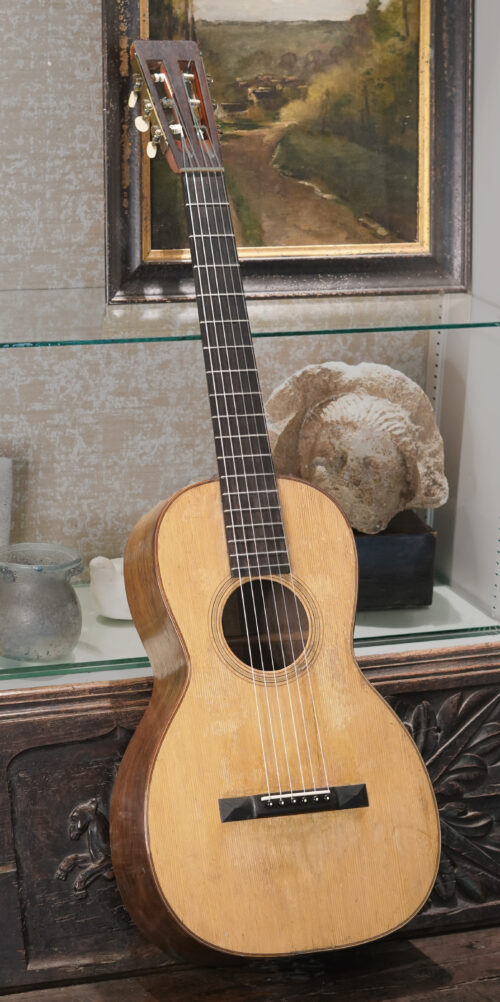
In this period, the Martin factory foreman often wrote the date of manufacture, before the guitar left the factory, hand-written in pencil on the underside of the top. This one has hand-written inside "5 / 1886". It’s a nice touch to a great Martin – and the size 2 is a great size, it’s a larger guitar than the more common size 2 ½ from this era.
Exquisite tone from this guitar. See and hear this guitar being played:
All careful work has been done on this guitar, including a perfect ebony bridge by T.J. Thompson, and it won’t need anything else. It’s an ideal guitar for the player who wants the best Martin tone and playability – a tonal gem from the 19th century Martin factory in Nazareth.
• Slot head, with original geared tuners
• Spruce top over Brazilian Rosewood back and sides.
• All original finish, with the exception of some minor touch up in the bridge area.
• Perfect reproduction ebony, pyramid bridge by T.J. Thompson.
Some touch-up in the bridge area of the spruce when the bridge was fitted.
• Fan braced – as are most of the best sounding Martins from this era.
• Original thin maple bridge plate, that has had some minor pin hole attention, by us, to ensure stability and protection from ball ends.
• Original ebony fretboard; Original bar frets. Frets have some wear, but we left them, for originality, and they play fast and low and smooth.
• Spanish heel (not the ice cream cone heel of the less expensive Martins of the era).
• Soft V neck
• End pin is original, tab end of the pin has come off but the shaft remains
• One inch area in the rosette, repaired (see photos)
• Three tiny holes near end pin are remnant of a tailpiece used at some point in the previous century
• One crack on top, just below the low E string (see photos). About 4 1/2 inches long. This crack has been glued, and is tight (no cleat due to proximity to a brace).
• Scale length: 24.5 inches
• Width at lower bout: 12 inches
• Nut width: 1 13/16 inch
The guitar has had a recent neck set (by us), so the action is great, and lower than what a lot of folks try to get away with on a 19th century Martin. This guitar does not have “classical guitar action.” The great Martins from this era were not then and they should not today be considered “classical guitars”. They are parlor guitars, and the best examples have the Martin sound we know and love, with a “classical” sound if we consider that sound from the 19th century not today.
No excuses on the action, tone, and playability on this guitar. Strung with Savarez Alliance strings. It plays so easily, with perfect intonation all the way up the fretboard, and the sound is stellar.
It ships in a modern hard shell case.
Price: $6,750. – plus shipping
-
Out of stock
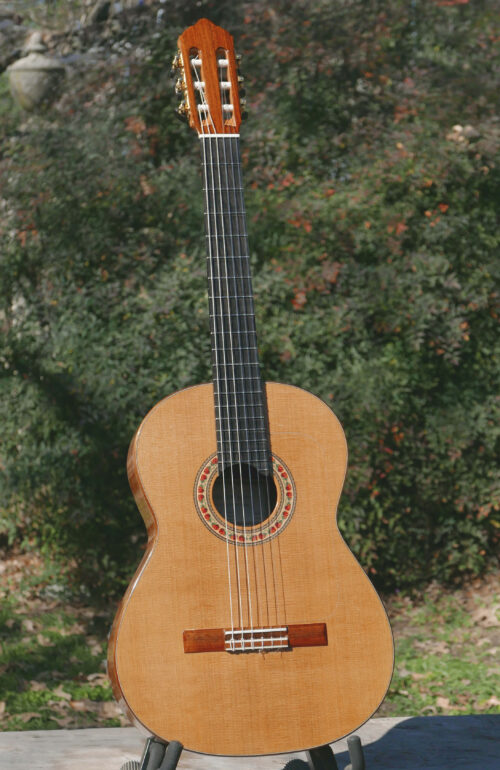 Guitars from the world-renown luthier Lester Devoe are highly sought after – to the extent of a formidable wait list for a new one. And vintage Devoe guitars – especially ones from this era – are hard to come by. So this guitar is a gem. And with close to 30 years of aged wood/tone, its sound is amazing. We’ve had several Devoe's over the years, but none like this one. The age, the fact that it’s a cedar top, its light build, and Lester’s magical touch combine to give this vintage Devoe a tone that is in a class by itself, with both the bold flamenco presence you’d expect, and nuances of color and timbre that many great/expensive classical guitars lack. Like a great classical guitar it responds to the lightest touch, and with deep round rosewood color, yet it’s a lightning storm for flamenco. You can hear/see this guitar in the sound/video clip posted here. https://www.youtube.com/watch?v=4m-M9yI6u9g 1995 Lester Devoe "Flamenco Negra", the term for a Flamenco guitar that has rosewood back and sides. See photo of label.
Guitars from the world-renown luthier Lester Devoe are highly sought after – to the extent of a formidable wait list for a new one. And vintage Devoe guitars – especially ones from this era – are hard to come by. So this guitar is a gem. And with close to 30 years of aged wood/tone, its sound is amazing. We’ve had several Devoe's over the years, but none like this one. The age, the fact that it’s a cedar top, its light build, and Lester’s magical touch combine to give this vintage Devoe a tone that is in a class by itself, with both the bold flamenco presence you’d expect, and nuances of color and timbre that many great/expensive classical guitars lack. Like a great classical guitar it responds to the lightest touch, and with deep round rosewood color, yet it’s a lightning storm for flamenco. You can hear/see this guitar in the sound/video clip posted here. https://www.youtube.com/watch?v=4m-M9yI6u9g 1995 Lester Devoe "Flamenco Negra", the term for a Flamenco guitar that has rosewood back and sides. See photo of label.- Cedar top, and Indian Rosewood back and sides
- Rosewood bridge
- Ebony fretboard
- 650mm scale length
- Sloan tuners
- Clear tap plate treble side
- All original nitrocellulose finish
- Rosette with “roses” design in the classic Andalusia tradition
- Great condition:
-
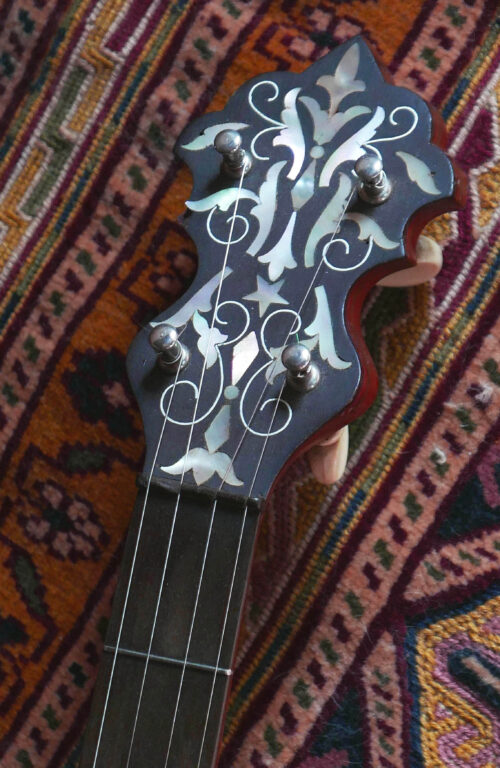 A rare, circa 1895 S.S. Stewart “Special Thoroughbred” 5-string banjo, in original condition. Silver plated pot 5-string neck is cherry Ebony fingerboard Carved heel Mother of pearl headstock inlays, with silver wire inserts also Tone ring is nickel plated on a birds-eye maple pot All of the special logos etc, are still on the inside of the banjo. Condition: amazing, original condition. Does have some wear, but it’s still shiny, and in great condition. (It even has its original leather case, not a very practical case, but original.) Tone is very nice, more focused and loud than the typical turn of the century open-back banjo. Price: $2950.
A rare, circa 1895 S.S. Stewart “Special Thoroughbred” 5-string banjo, in original condition. Silver plated pot 5-string neck is cherry Ebony fingerboard Carved heel Mother of pearl headstock inlays, with silver wire inserts also Tone ring is nickel plated on a birds-eye maple pot All of the special logos etc, are still on the inside of the banjo. Condition: amazing, original condition. Does have some wear, but it’s still shiny, and in great condition. (It even has its original leather case, not a very practical case, but original.) Tone is very nice, more focused and loud than the typical turn of the century open-back banjo. Price: $2950. -
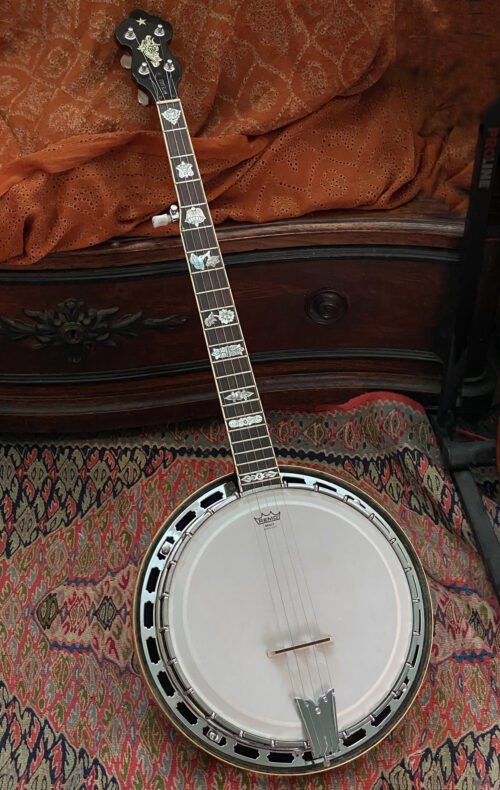
Rare Alvarez Whyte Eagle 5 string Banjo very early production
Early 1970s, but in remarkably original condition. And this instrument is from the first, early production– so it has the maple 3-ply rim. This should not be compared to later production Whyte Eagles in the 70's – this is a very rare early one with unique features, described below, and great tone.
This banjo design is based on:
• neck/head/inlays: based on the high end Fairbanks Whyte Ladye of the early 20th century– one of the most beautiful designs in banjo history
• the pot assembly is modeled closely on the Gibson TB3, archtop of the 1930's. In fact it's a remarkable recreation of that design (and sound) – a more faithful recreation that many Gibson post-war versions.Bluegrass banjo players seek out the 70’s Alvarez Whyte Eagles, known for their tone and craftsmanship. It was a pretty short window of only about five years, when these banjos were made with this kind of craftsmanship. They blow away most any banjo made and marketed (from any country) in the 60s, 70s and 80s– and they show no logos on headstock– just beautiful mother of pearl. It’s the model 4310 “Whyte Eagle”. Based on late 1920’s Vega Griffin (Tubaphone #9) style inlays, with engraved, carved heel. Sunburst finish maple banjo, Gibson-style 2 piece flange, full height 20 hole archtop tone ring, dual coordinator rods, flamed maple resonator, maple neck, chrome finish. Neck is butterfly with ebony strip on back of neck, down the center.
It’s extremely rare to find a Whyte Eagle from this very early period (serial number is 1776), when they first came out and the company bent over backwards to produce an instrument with zero compromise, from the inlays to the maple rim. The early features that are not on the later 70's Whyte Eagles, are – in addition to the 3-ply maple rim (not the 10-ply rim of almost all other Whyte Eagles) – the smaller star on the front of headstock (later models had a larger star), no “Alvarez” logo just the eagle inlay, and a darker sunburst on the resonator and also on the back of the neck.
Flamed maple resonator (sunburst back, with some of milkiness to the original finish)
Maple butterfly neck
Hand-carved heel
Mother of pearl inlays
Original tuners
Grover bridge
1 3/16 nut
Scale: 26 ¼ inches
20 hole archtop tone ring
11 inch head
With original hard shell case. Price $1850.
-
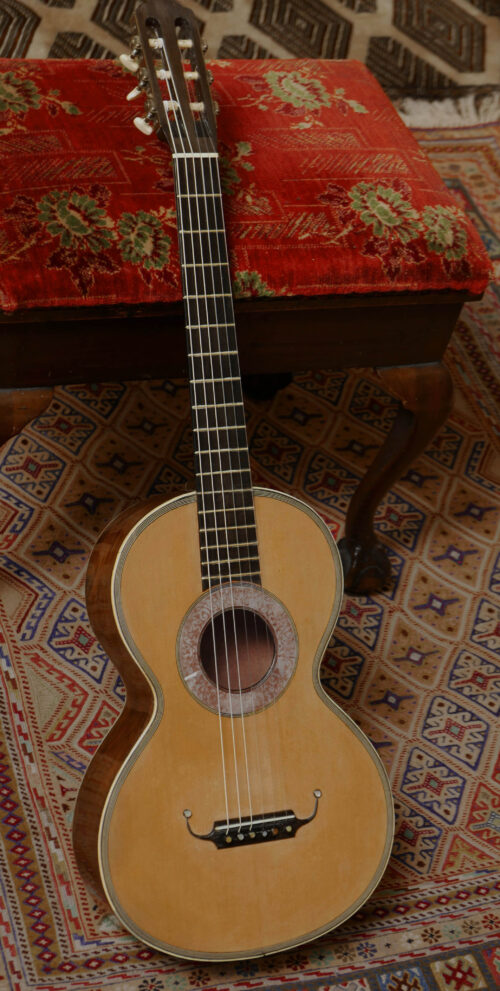 Pierre Marcard, well-known luthier in France, 1794-1867. This guitar is from about 1845–1850. Signed with the maker’s stamp/signature on inside, back (see photo). • All original: finish, bridge, frets, endpin, everything • Spruce top • Ebony bridge • Finely decorated mother of pearl rosette • Brazilian rosewood/maple laminate back • Solid Brazilian rosewood sides (note this is rare: solid, it was an upgrade from the standard practice of the day to do laminate sides as well. • Scale length: 632mm • Nut width: 46mm You can see a sound/video clip of this guitar being played, here: https://www.youtube.com/watch?v=Ryf25bMcmt4 Condition: Amazing original condition. • Similar to other fine guitars of that era, from Lacote and others, the "finish" on the top of the guitar – still all original finish and unmolested – is super thin. Those master French luthiers thought that less finish on top, was better. • No cracks on top, back, sides • A few tiny and superficial surface “cracks” on a few sections of binding • Bridge, all original, has never been off the instrument. Saddle looks original. The bridge does have a few cracks in the ebony, parallel to the length of the bridge. We have left them as is, for originality (a luthier might fill in the tiny gaps with ebony paste – the structure/integrity of the bridge is good.) • The bridge pins look original to the guitar, but hard to verify that. • Action of the guitar is good, consistent with mid nineteenth century standards. • Tone of the guitar, is excellent. Good projection for this sized instrument. Playability is very good– with good intonation even at high registers. Price: $8250. Will ship in a modern hard shell case.
Pierre Marcard, well-known luthier in France, 1794-1867. This guitar is from about 1845–1850. Signed with the maker’s stamp/signature on inside, back (see photo). • All original: finish, bridge, frets, endpin, everything • Spruce top • Ebony bridge • Finely decorated mother of pearl rosette • Brazilian rosewood/maple laminate back • Solid Brazilian rosewood sides (note this is rare: solid, it was an upgrade from the standard practice of the day to do laminate sides as well. • Scale length: 632mm • Nut width: 46mm You can see a sound/video clip of this guitar being played, here: https://www.youtube.com/watch?v=Ryf25bMcmt4 Condition: Amazing original condition. • Similar to other fine guitars of that era, from Lacote and others, the "finish" on the top of the guitar – still all original finish and unmolested – is super thin. Those master French luthiers thought that less finish on top, was better. • No cracks on top, back, sides • A few tiny and superficial surface “cracks” on a few sections of binding • Bridge, all original, has never been off the instrument. Saddle looks original. The bridge does have a few cracks in the ebony, parallel to the length of the bridge. We have left them as is, for originality (a luthier might fill in the tiny gaps with ebony paste – the structure/integrity of the bridge is good.) • The bridge pins look original to the guitar, but hard to verify that. • Action of the guitar is good, consistent with mid nineteenth century standards. • Tone of the guitar, is excellent. Good projection for this sized instrument. Playability is very good– with good intonation even at high registers. Price: $8250. Will ship in a modern hard shell case. -
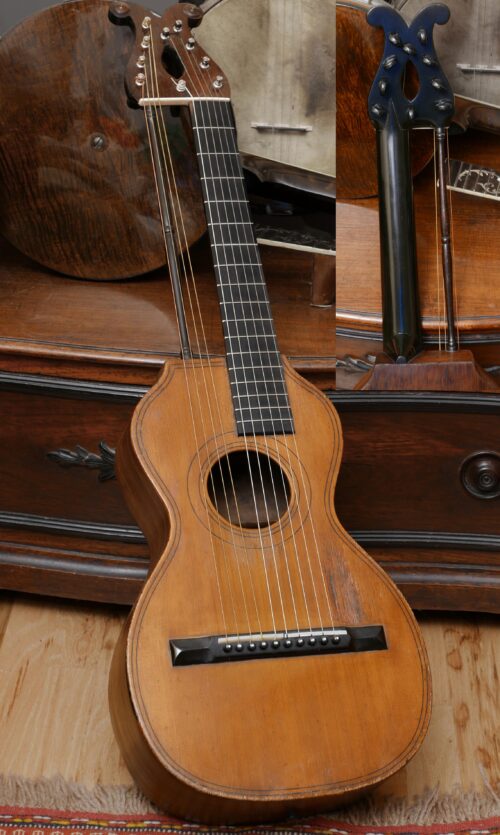 This 10 string harp guitar has no markings no it, i.e. no maker's label, stamp, signature etc. Probably American, likely a one-of-a-kind made by someone we'll never know – but it’s very similar to the 1860 "Renaissance" Martin harp guitar that’s well documented. See/hear the video of this guitar being played: https://www.youtube.com/watch?v=ddxma5gCI7Q 10 string Harp guitar: • Width at lower bout: 12 1/4 inches • It’s deep: 4 ¼ inches at bottom/end pin, 3 /12 deep at neck joint. • Scale length: 24 1/2 inches • Nut width of six-string portion: 1 7/8 inches; string spacing of six strings on the regular guitar portion: 1 ½ inches • Ladder braced – no cracks, bellying, etc, on the original top • Solid Adirondack top, with original finish • Back, and sides: Brazilian rosewood and spruce laminate (similar to some Ashborns, and some Martins from that era). There has been some restoration to the sides, where a few pieces of Brazilian were missing/chipped, as well as to the back (in other words: sections of the outer brazilian layer have been replaced. • Ebony bridge, original. It has been off, and back on • The tuners are modern banjo tuners • Ice cream cone heel, and the neck's been "ebonized". While the neck, fretboard, and head have been restored (recently), the original design is intact. • Neck is Maple – "ebonized" but it's a solid maple neck Price: $6950.
This 10 string harp guitar has no markings no it, i.e. no maker's label, stamp, signature etc. Probably American, likely a one-of-a-kind made by someone we'll never know – but it’s very similar to the 1860 "Renaissance" Martin harp guitar that’s well documented. See/hear the video of this guitar being played: https://www.youtube.com/watch?v=ddxma5gCI7Q 10 string Harp guitar: • Width at lower bout: 12 1/4 inches • It’s deep: 4 ¼ inches at bottom/end pin, 3 /12 deep at neck joint. • Scale length: 24 1/2 inches • Nut width of six-string portion: 1 7/8 inches; string spacing of six strings on the regular guitar portion: 1 ½ inches • Ladder braced – no cracks, bellying, etc, on the original top • Solid Adirondack top, with original finish • Back, and sides: Brazilian rosewood and spruce laminate (similar to some Ashborns, and some Martins from that era). There has been some restoration to the sides, where a few pieces of Brazilian were missing/chipped, as well as to the back (in other words: sections of the outer brazilian layer have been replaced. • Ebony bridge, original. It has been off, and back on • The tuners are modern banjo tuners • Ice cream cone heel, and the neck's been "ebonized". While the neck, fretboard, and head have been restored (recently), the original design is intact. • Neck is Maple – "ebonized" but it's a solid maple neck Price: $6950. -
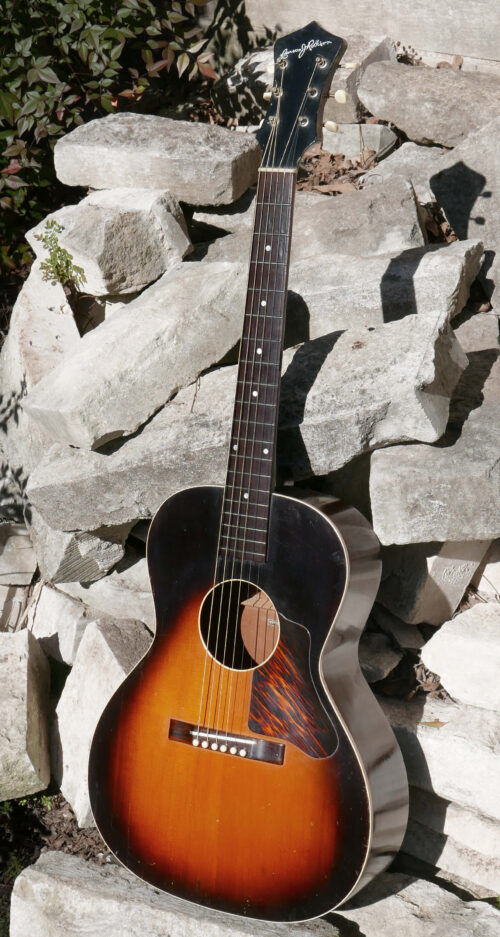 Made in 1937 – it is stamped inside from the Gibson/Kalamazoo factory: “September 1937” • Gibson L-00 (and same as Kalamazoo) body shape with ladder-bracing... all were made in the same Gibson factory. • 24 3/4" Gibson scale length • 1 3/4" nut width • Classic V-shape neck profile, typical of the golden age Gibsons of the mid-1930’s • Adirondack spruce top • Mahogany back and sides • 100% original finish, everywhere • Three hairline cracks on top that are hard to see. (upper bout; bass side near fretboard extension; and below bridge.) They’ve been glued inside. Couple of cracks on back, also have been addressed. Sides are crack-free. • Original Gibson firestripe pick guard • Original tuners (the G string tuner is bent a bit – we prefer to leave it like it is, it works fine, rather than bend it back) • Original Brazilian rosewood bridge, has never been off the guitar. • Brazilian rosewood fingerboard, shows a bit of wear • Original frets, in good condition • Original nut • Original small Maple bridge plate; and all braces inside are original and in great condition. • In a modern hard shell case Price: $3950.
Made in 1937 – it is stamped inside from the Gibson/Kalamazoo factory: “September 1937” • Gibson L-00 (and same as Kalamazoo) body shape with ladder-bracing... all were made in the same Gibson factory. • 24 3/4" Gibson scale length • 1 3/4" nut width • Classic V-shape neck profile, typical of the golden age Gibsons of the mid-1930’s • Adirondack spruce top • Mahogany back and sides • 100% original finish, everywhere • Three hairline cracks on top that are hard to see. (upper bout; bass side near fretboard extension; and below bridge.) They’ve been glued inside. Couple of cracks on back, also have been addressed. Sides are crack-free. • Original Gibson firestripe pick guard • Original tuners (the G string tuner is bent a bit – we prefer to leave it like it is, it works fine, rather than bend it back) • Original Brazilian rosewood bridge, has never been off the guitar. • Brazilian rosewood fingerboard, shows a bit of wear • Original frets, in good condition • Original nut • Original small Maple bridge plate; and all braces inside are original and in great condition. • In a modern hard shell case Price: $3950. -
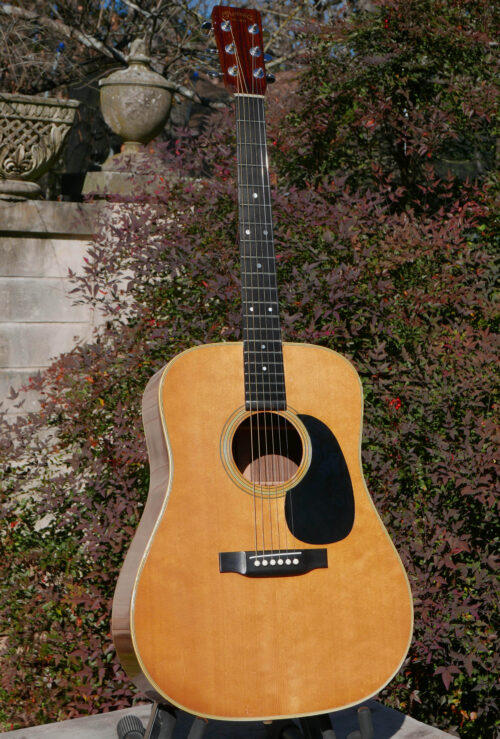 Martin D-28, made very early in 1970. Great tone, great original condition. • The finest, excellent quality Indian Rosewood back, sides, peghead veneer • Sitka Spruce top – and this is not the “streaky” sitka spruce. There are no dark streaks. Note light areas: that is “Bear claw”. • Ebony fingerboard and bridge. • Completely original. This guitar has had no repairs at all. • Original bridge, saddle, nut, pickguard • The guitar has no cracks, anywhere • Addition of a strap button on the neck heel. • Slight marks just above the nut, on bass side, caused from a strap that was worn under the strings on the peghead • The original Black Hard case (one of the last before Martin went to the Blue Plastic cases) is also very clean with no serious scrapes or bruises. One of the finest examples of 60s/early 1970 D28 available. Price: $5250.
Martin D-28, made very early in 1970. Great tone, great original condition. • The finest, excellent quality Indian Rosewood back, sides, peghead veneer • Sitka Spruce top – and this is not the “streaky” sitka spruce. There are no dark streaks. Note light areas: that is “Bear claw”. • Ebony fingerboard and bridge. • Completely original. This guitar has had no repairs at all. • Original bridge, saddle, nut, pickguard • The guitar has no cracks, anywhere • Addition of a strap button on the neck heel. • Slight marks just above the nut, on bass side, caused from a strap that was worn under the strings on the peghead • The original Black Hard case (one of the last before Martin went to the Blue Plastic cases) is also very clean with no serious scrapes or bruises. One of the finest examples of 60s/early 1970 D28 available. Price: $5250.